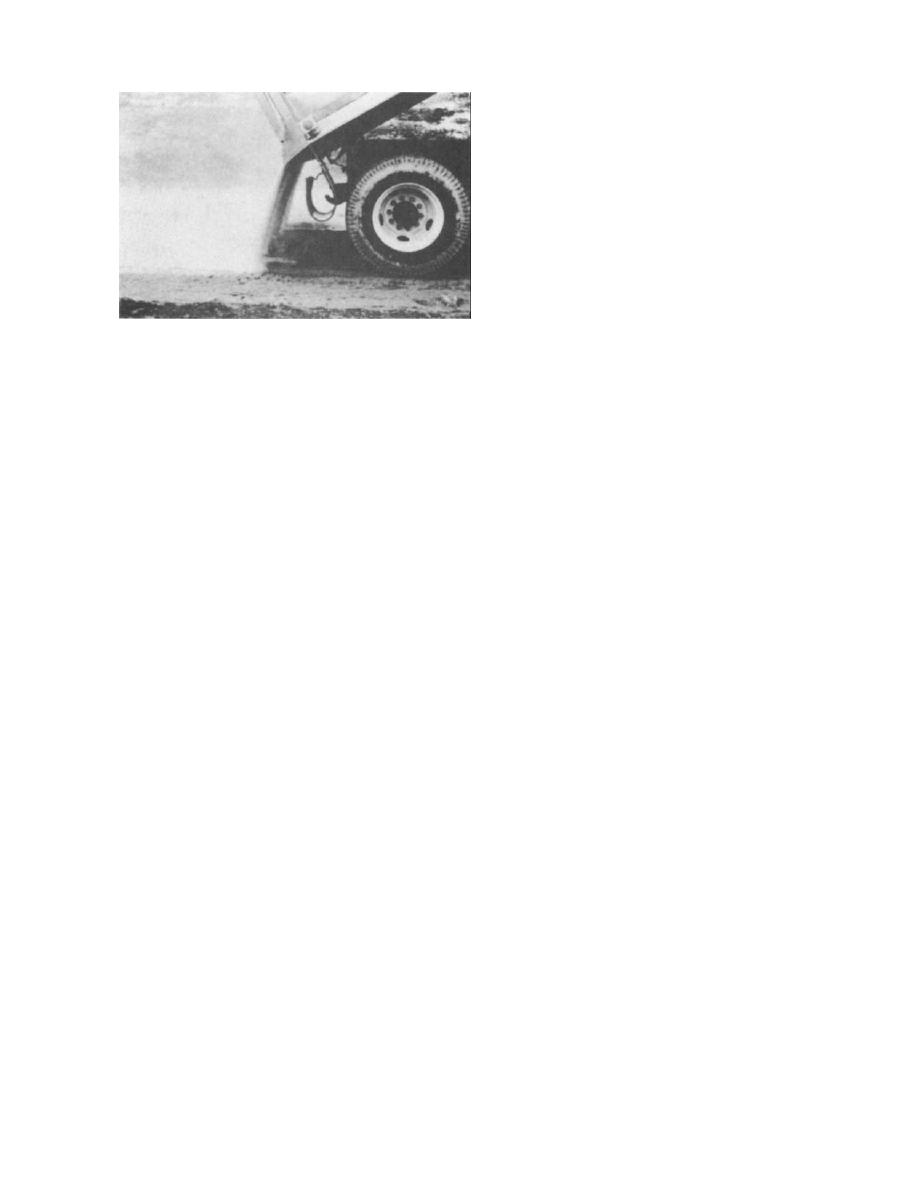
TM
5-822-14/AFJMAN
32-1019
mixing; the same pump loaded the tank trucks. To
keep the lime from settling, the contractor devised
a hand-operated scraper fitted with air jets. The
newest and most efficient method of slurry produc-
tion, which eliminates batching tanks, involves
the use of a compact jet slurry mixer. Water at 70
pounds per square inch and hydrated lime are
charged continuously in a 65:35 (weight) ratio into
the jet mixing bowl where slurry is produced
instantaneously. The mixer and auxiliary equip-
ment can be mounted on a small trailer and
transported to the job readily, giving great flexibil-
ity to the operation. In the third type of slurry
setup, measured amounts of water and lime are
Figure 4-28. Spreading of granular quicklime.
charged separately to the tank truck, with the
slurry being mixed in the tank either by com-
required over a measured area to achieve the
pressed air or by a recirculating pump mounted at
specified percentage based on lime solids content.
the rear. The water is metered and the lime
To prevent runoff and consequent nonuniformity of
proportioned volumetrically or by means of weight
lime distribution that may occur under certain
batchers. Both portable and permanent batching
conditions, it may be necessary to mix the slurry
plants are used. Mixing with air is accomplished
and soil immediately after each spreading pass (fig
at the plant. The air jets are turned on during the
4-33). A typical slurry mix proportion is 1 ton of
loading operation, and remain on until the slurry
lime and 500 gallons of water, which yields about
is thoroughly mixed which takes about 10 to 15
600 gallons of slurry containing 31 percent lime
minutes. The use of a recirculating pump, how-
solids. At higher concentrations there is difficulty
ever, permits mixing to occur during transit to the
in pumping and spraying the slurry. Forty percent
job. Usually, 2-, 3-, or 4-inch pumps are used in
solids is a maximum pumpable slurry. The actual
this operation, with the slurry being recirculated
proportion used depends on the percentage of lime
through the tank by means of a perforated longitu-
dinal pipe extending the length of the tank and
specified, type of soil, and its moisture condition.
When small lime percentages are required, the
capped at one end. Spreading from the slurry
distributors is effected by gravity or by pressure
slurry proportions may be reduced to 1 ton of lime
spray bars, the latter being preferred because of
per 700 to 800 gallons of water. Where the soil
better distribution. The use of spray deflectors is
moisture content is near optimum, a stronger lime
concentration would normally be required. In
also recommended for good distribution. The gen-
eral practice in spreading is to make either one or
plants employing central mixing, agitation is usu-
two passes per load. However, several loads may
ally accomplished by using compressed air and
be needed in order to distribute the required
recirculating pump, although pugmills have also
amount of lime. The total number of passes will
been used. The most typical slurry plant incorpo-
rates slurry tanks large enough to handle whole
depend on the lime requirement, optimum mois-
tank truck loads of hydrated lime of approximately
ture of the soil, and type of mixing employed.
Windrow mixing with the grader generally re-
20 tons. For example, on one job two 15,000 gallon
tanks, 10 feet in diameter by 26 feet in length,
quires several passes.
(e) Double application of lime. In some areas
were used, each fitted with an 8-inch perforated
air line mounted along the bottom. The air line
where extremely plastic, gumbo clay (PI 50+)
abounds, it may prove advantageous to add the
was stopped 18 inches short of the end wall,
thereby providing maximum agitation in the lime-
requisite amount of lime in two increments to
facilitate adequate pulverization and obtain com-
feeding zone. A typical batch consisted of 10,000
plete stabilization. For example, 2 or 3 percent
gallons of water (charged first) and 20 tons of lime,
lime is added first, partially mixed, then the layer
producing about 12,000 gallons of slurry in less
is sealed and allowed to cure for up to a week. The
than 25 minutes. Loading of the tank trucks was
remaining lime is then added preparatory to final
handled by a standard water pump, with one
mixing. The first application mellows the clay and
slurry tank being unloaded while the slurry was
helps in achieving final pulverization, and the
being mixed in the other tank. On another job the
second application completes the lime-treatment
contractor used a similar tank and air line, but, in
process.
addition, a 4-inch recirculating pump was used for
4-15


 Previous Page
Previous Page
